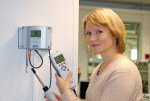
There are many ways to approach the calibration and adjustment of relative humidity instruments. In a perfect world, all instruments would be checked and certified in accredited laboratories to the highest standards. In the real world, we must balance time, cost, technical requirements, expertise, and the unique needs of each specific user organization.
There are four concepts common to all calibration work that should be clarified:
- Calibration – The act of comparing an instrument’s measurement to a known standard.
- Adjustment – The act of adjusting an instrument to match a standard
- Calibration interval – The time elapsed between successive calibrations of an instrument.
- Working standard – An instrument calibrated against either a secondary or primary standard and used to calibrate other instruments.
The word “calibration” is sometimes interpreted to mean comparison and adjustment, but it is safest not to assume that calibration includes an adjustment to an instrument.
Users often ask manufacturers for a recommended calibration interval. This is a reasonable starting point, but in practice, instrument performance may degrade at different rates depending on the use of the instrument, so establishing an appropriate calibration interval is recommendable. Read the metrologist’s approach to this problem and other useful facts here.
